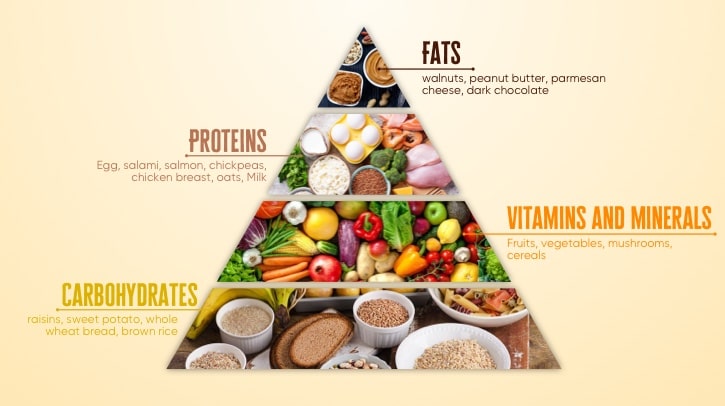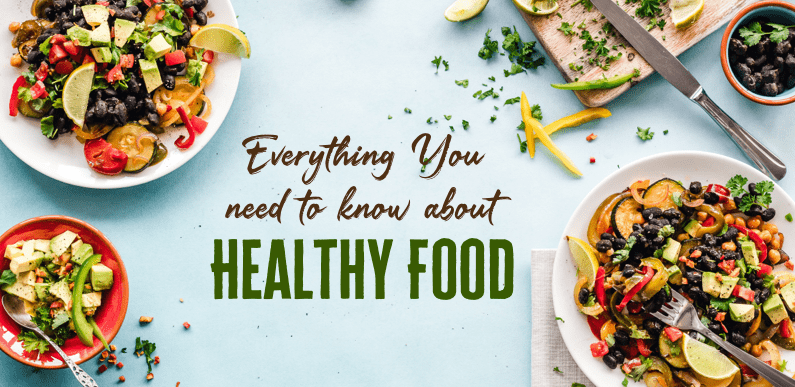Food is one of the essential things in our lives, and we eat to live, not live to eat. But with so many conflicting claims about what’s good for you, it cannot be easy to know what to eat.
But you can make better decisions regarding your plate by learning what to eat and avoid. Healthy food is not just a trend.
It’s a way of life. There’s no need to sacrifice taste or nutrition when you choose healthy options over unhealthy ones.
A healthy eating plate:
Everybody must have tried to understand how the food pyramid works. A food pyramid is a variety of food items you should consume to ensure that your body gets enough nutrients and vitamins.

1) Fats – walnuts, peanut butter, parmesan cheese, dark chocolate.
2)Proteins- Egg, salami, salmon, chickpeas, chicken breast, oats, Milk.
3) Vitamins and minerals- Fruits, vegetables, mushrooms, cereals.
4) Carbohydrates- raisins, sweet potato, whole wheat bread, brown rice.
What should a healthy eating plate include?
1. Fats- once upon a time, dietary fat was avoided and was considered a significant contributor to heart disease. Still, according to researchers, at least 20% of fat should be eaten, with only 10% saturated fat.
High-fat- foods which are highly nutritional and pocket-friendly:
- Cheese – Cheese is an excellent source of vitamin B12, calcium, phosphorus, and other beneficial nutrients. Unlike other high-fat dairy, cheese doesn’t increase the risk of heart disease.
- Dark Chocolate- Dark chocolate is very high in fats, up to 65% of calories. It is loaded with antioxidants called resveratrol which is even used in wine to enhance health benefits and possess anti-ageing properties.
- Walnuts- Walnuts are incredibly healthy. They have high fibre and fats and are loaded with magnesium and vitamin- E.
- Peanut butter- Eating peanut butter at a moderate level for your diet has several advantages, including reducing the risk of breast disease and weight loss.
2. Proteins- Many people prefer high protein intake in their diet. Studies show that it has numerous benefits, such as it helps in reducing hunger levels which allow for weight loss, increases muscle mass, and boosts metabolism resulting in fat burning.
A few delicious food items that are high in protein:
- Egg- Eggs contain vitamins, minerals, and antioxidants, and they are also excellent sources of protein. They are also rich in choline, which helps during pregnancy and breastfeeding because it plays a significant role in development and growth.
- Salami – Salami is low in fats yet high in proteins. It doesn’t require cooking and is usually sold raw, ready–to–eat. It supports digestion and also builds immunity.
- Salmon- Salmon is widely available and very tasty to eat. Additionally, it is a good source of protein and omega-3 fats; it also promotes brain function and prevents inflammation.
- Chickpeas – Chickpeas, also known as ‘Garbanzo’, have 22% proteins. Half a cup of chickpeas serving has 10 to 15 grams of proteins. They are optimal for building muscles.
- Chicken breast- If you want to boost the intake of proteins, then eating a chicken breast is a fantastic choice. A wide range of recipes which are super easy to cook includes chicken breast.
- Oats- Oats are low- cost source of protein, which comes with a good amount of nutritional value.
- Milk – Milk contains almost every single nutrient that a body needs. It provides calcium, proteins, vitamins and minerals.
3. Vitamins and minerals- The ‘Sailor’ of our ship vitamins and minerals has many different health benefits, which include the growth of cells, helping to build higher bone mass, healing wounds, and strengthening the immune system.
- Fruits – A fruit-rich diet can lower your blood pressure, prevent a few types of cancer, and reduce the risk of stroke and heart disease. It even promotes weight- loss.
- Vegetables- Vegetables have low calories but are high in nutrients, which is why doctors recommend you consume them daily.
- Mushrooms – Mushrooms are rich in protein and a good source of fibre and antioxidants. They also mitigate the risk of diseases like diabetes and Alzheimer’s.
- Cereals- Cereals are a good source of energy and fibre. It is rich in minerals and vitamins, which help keep your sugar levels healthy.
4. Carbohydrates- Many diets don’t include or reduce carbohydrates. For having a healthy diet, even carbohydrate is necessary.
- Raisins – Raisins are naturally sugared and are high in calories. It boosts iron and keeps your brain strong.
- Sweet potato- Starchy root vegetable – sweet potato is grown worldwide in different shapes and sizes. Have high nutritional value, stimulate gut health, and even enhance brain functions.
- Whole wheat bread – While a high intake of bread links to obesity and inflammation, whole grains enter like a hero. Studies show that the intake of whole grains lowers blood sugar levels and improves insulin sensitivity.
- Brown rice- Brown rice is rich in phenols and flavonoids, reduces damage to cells and even reduces the risk of premature ageing.
The bottom line
We all are humans who want to grow and adapt to changes constantly. In the same way, the belief in healthy eating should transform and spread throughout.
Healthy eating differs from person to person. Contemplate what you can add to eating healthy and adapt the changes accordingly.
👉🏻 For more Accountability-related blogs, click here
https://fns360.com/blog/category/accountability-2/.
👉 You can also check out more such videos, The Huddle with Coach Brian Nunez – Mindset Motivation & Interviews.






